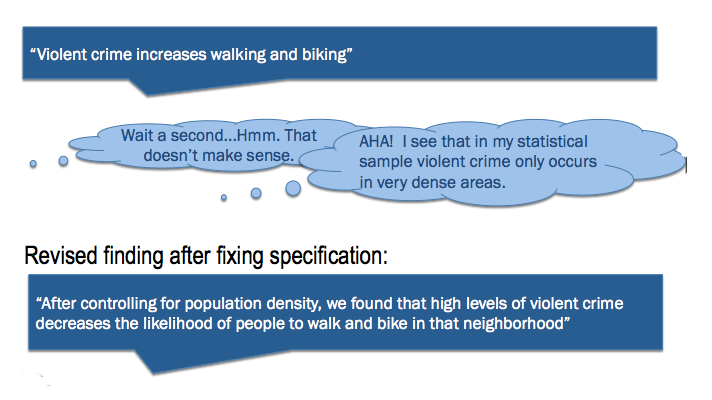Choice Model Development in Practice
There are a few items that are useful to keep in mind when developing a choice model for use within a larger travel model framework that might not be applicable or on the radar for modelers developing specifications for use in research.
# Good Attributes
A good choice model usually has the following attributes:
- Practical to use
- Consistent with evidence and common sense
- Useful to researchers or decision-makers
- ...might not be the most statistically strong (in fact, it probably isn't)
Developing a choice model is as much art as it is science. This is especially true when developing a model that will be used in practice.
# Practical
# Inputs are Forecastable
Can you (easily and reliably) forecast your independent variables?
Possibly suspect/difficult variables:
- [ = f( Yelp Scores)
- Residential Location Choice = f ( School Quality)
- Bike Utility = f(potholes)
- Walk Utility = f(violent crime)
Remember: Garbage In Garbage Out 
# Do mechanics work with your travel model?
Are these variables "available to you" in your model system?
- Person/HH/trip level (easier in microsimulation framework)
- LOS variables (çan you 'skim' them?)
Does adding this variable significantly contribute to run time, memory, or storage requirements?
# Consistent
# Use Common Sense
If your findings are inconsistent with past research, common sense, and anecdotal evidence, you have done one of the following:
- Made a discovery (yay!)
- Come across a statistical anomaly (annoying…)
- Poorly specified your variable (bad!)
Possible questions to help you differentiate garbage from discovery:
- can you talk about your finding with a straight face?
- can you tell a story?
- are there underlying missing variables?
- are there multiple variables obscuring each other?
- is the sample robust enough?
Example Model Revision:

# Useful
"Does [ whatever specification you are considering] have valid and relevant sensitivities?"
:
: AKA
"…will it make sense and will anybody care?"
# Is Your Model Specification Valid?
Example 1
Possible Model: : Transit utility increases with TAZ population
Incorrect Implication: : We can increase transit usage by making our TAZs larger
Better Model (find the real cause): : Transit utility increases with shorter walk access distances and more frequent transit service (which happen to be common in dense areas with high TAZ populations)
Example 2
Possible Model: : Bike LOS increases as the average traffic / lane at an intersection decreases
Incorrect Implication: : We can get more people to bike by widening roads at intersections
Better Model (find the real cause): : Bike LOS increases as conflicts with cars decrease
# Is Your Model Specification Relevant?
"What questions are you trying to answer?"
Make sure you have the sensitivity you need to answer your boss's boss's questions.
Example are parking maximums the next hot political battle in your region? make sure you have parking competitiveness in your models!
